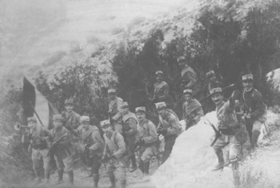French Armenian Legion
| Armenian Legion | |
|---|---|
 |
|
| Active | 1916–1920 |
| Country |
|
| Size | 4,124 (1916–1918) 10,150 (1920–1921) |
| Nickname(s) | "La Légion d'Orient" |
| Engagements | Battle of Arara (Sinai and Palestine Campaign), Battle of Marash, Franco-Turkish War |
| Commanders | |
| Ceremonial chief | Boghos Nubar |
The Armenian Legion (French: Légion arménienne) was a foreign legion unit within the French Army active during and just after World War I which fought against the Ottoman Empire. The original name of the legion was "La Légion d'Orient" (The Eastern Legion). It was renamed "La Légion Arménienne" (The Armenian Legion) on February 1, 1919. The soldiers in this legion were referred to informally among Armenians as Gamavor (Volunteer).
Many Armenians living in France volunteered to join the French Foreign Legion at the beginning of the war. This was prior to the establishment of the French Armenian Legion.
Negotiations of Boghos Nubar with French political and military authorities culminated in the formation of the French Armenian Legion.
The Legion was established officially in Cairo, Egypt in November 1916, with the accord of the French Ministry of Foreign Affairs and an Armenian delegation. Several Armenian organizations pledged contributions to form several battalions under the planned Armenian Legion.
The parties agreed to the following:
Signed in Paris by General Pierre Roques, Minister of War, and General Marie-Jean-Lucien Lacaze, Minister of Navy, the official decision regarding the establishment of the Armenian Legion was signed on 15 November 1916 in Paris.
According to this initial decision,
The number of volunteers was an equivalent of 6 battalions, each containing 800 volunteers, and another 6 battalions was planned to be formed. Armenian committees were organizing to recruit these soldiers in France and United States.
Ninety-five percent Armenian in composition, the Legion included Ottoman Armenian refugees, former prisoners of war, and permanent residents of Egypt, America, and Europe. The majority of the soldiers were said to be recruits from the Armenian-American community or survivors of the battle of Musa Dagh who were living in refugee camps in Port Said, Egypt, at the time.
...
Wikipedia
